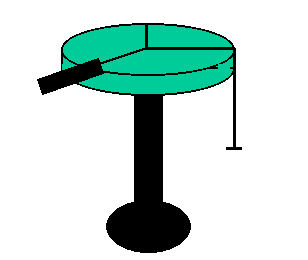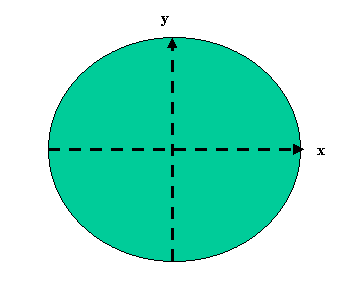

 PYL
105: Lab 4
PYL
105: Lab 4



Forces and Vectors
According to Newton's Second Law
F = m a,
if there is a net force acting on an object, then the object will
accelerate. In this experiment we will consider a situation of
static equilibrium, i.e. a
case in which nothing is moving. If an object is not moving, then it is
certainly not accelerating. And then using Newton's Second Law we can further
conclude that there is no net force on the object. No net force does not mean
there are no forces on the object, nor does it mean no motion, but rather that
the effects of all of the individual forces cancel, and there is no acceleration
(no change in whatever the velocity might be).
Forces have a both a magnitude and a direction. The
magnitude tells one the size of the push or pull supplied by the force, while
the direction tells which way the object is being pushed or pulled. Forces are
thus represented mathematically by vectors. A quantity must have certain
properties in order for it to be considered a vector. For instance, there are
rules expressing vectors in terms of components and rules for adding vectors.
Expressing a vector in terms of its components is also known
as "resolving" it. Let us consider resolving a force F into
components. Find the angle between the x axis and F as shown
below. There are two conventions for measuring angles:
- To measure the angle starting from the positive x axis, proceeding in a counter-clockwise direction
and ending on the vector of interest. This approach results in angles between
0 and 360 degrees.
- To measure the angle between the x axis (positive or negative, whichever is closer)
and the vector of interest. This approach yields angles between 0 and 90
degrees, and one must further keep track of which quadrant the vector lies in.
We'll adopt the second method in the following discussion.
Another thing to keep in mind when dealing with angles is to keep
track of whether one is working with degrees or radians.

We can think of F and its x and y components (Fx
and Fy) as the sides of a right triangle, with F
as the hypoteneuse and the components as the legs. Using the
trigonometric relation that
cos q =
adjacent / hypoteneuse
we can determine that with the angle as drawn above, Fx,
the x component of F is, up to a sign, given by
Fx = |F| cos q
where |F| is the magnitude of F. Similarly, up to
a sign the y component of F3 is given by
Fy = |F| sin q
the magnitude of F times sin theta. The signs can be determined by
what quadrant one is in
| Quadrant |
Sign of x
component |
Sign of y
component |
| I |
+ |
+ |
| II |
- |
+ |
| III |
- |
- |
| IV |
+ |
- |
Part I. Calibrating the Force Sensor.
- Attach a force sensor to a ringstand as shown below.

- As usual the Signal Interface should have been turned
on before the computer. Plug the Force Sensor into Analog Channel A. Bring up
Science Workshop and drag the analog plug icon into the Analog Channel A icon,
and choose Force Sensor from the menu.
- BEFORE hanging a hanger
from the Force Sensor, press the TARE button on the side of it. This step is
supposed to establish the "zero" of the Force Sensor.
- Hang the hanger from the force sensor. Add a mass of
100 g.
- Press REC and take force data for a few seconds.
- Table the data and press the SIGMA button to obtain
the mean force. We are only interested in getting the magnitude of the force
(which is necessarily positive) from the source, so you don't have to worry
about the negative sign the force sensor gives.
- Repeat the measurements with 200 g and 300g on the
hanger.
| Mass (kg) | Force (N)
(Measured) |
Force (N)
(Theory, mg) |
| 0.150 | | |
| 0.250 | | |
| 0.350 | | |
Do you observe any errors in your force sensor readings? If
so, are they systematic or random? Explain.
Part II. Resolving the force vector into components.
- Tie three strings to washer. Two of the strings should be
of a length such that if the washer is in the center of the
force table, the strings can pass over a pulley at the edge of
the table and hang several centimeters below table level.

- Attach the two longer strings to hangers, and we want the
hangers to hang several centimeters below the pulleys and several
centimeters above the lab table as well.
- The length of the third string should be slightly longer than
the radius of the force table. We will be attaching the third
string to the Force Sensor.
- Put one pulley at 360 and the second at 90. Place the longer
strings over the pulleys and suspend hangers from them. Add unequal
masses (at least 100 g) to the hangers and determine the weight of
each (multiply by g=9.8 m/s2, don't forget the mass of
the hanger).

- Attach the hook of the Force Sensor to a loop at the end of
your shorter string. Hold the Force Sensor so that the strings
attached to the washer are horizontal (not vertical!) and
so that the washer is over the center of the force table. Hold it there as
steadily as possible while one partner clicks on Record in Science Workshop --
you only need a few seconds. Also note the angle of the string attached to the
Force Sensor (the angles are marked on the Force Table). Some groups attaching
the Force Sensor to a ringstand.
- Record the mean magnitude of the force.
- We will first want a coordinate system; we will take the x
direction to point in the radial direction from the center of the
table toward the 360 degree mark and the y direction to point
in the radial direction from the center of the table to the 90
degree.

Let us draw the three forces in this coordinate system.

(Sometimes when picturing vectors the lengths of the lines are
meant to be proportional to the magnitudes of the vectors. This is
not true in this picture.) The way we have set it up and the
way we chose the coordinate system F1 has only a
positive x component and F2 has only a positive y
component.
- The way vectors add is that one adds their components. So the
x component of the net force (F1+F2 +
F3) will in this case be
F1 + F3x
and the corresponding y component will be
F2 + F3y
For a vector to be zero, all of its components must be zero. Thus
the two expressions above should yield zero. Verify this.
| Magnitude | Angle |
Quadrant | Fx |
Fy |
| Force 1 | | |
| | |
| Force 2 | | |
| | |
| Force 3 | | |
| | |
| Sum | | |
| | |
- Change one of the masses (make a change of at least
50 grams) and repeat the measurement and calculations.
| Magnitude | Angle |
Quadrant | Fx |
Fy |
| Force 1 | | |
| | |
| Force 2 | | |
| | |
| Force 3 | | |
| | |
| Sum | | |
| | |
Are the sums of the components acceptably close to zero?
(Take into account any Force Sensor errors you observed in
part I.)
Part III. Adding vectors.
Did Force 3 change substantially when you replaced Forces 1 and 4
with Force G? Are any differences acceptable? Explain.
Part IV Pulley Effect
Arrange your apparatus based on the figure below.
When W1 (pan and added mass) has a mass of 100g what is the sensor's reading? Repeat with 150g, 200g and 250g. What is the sensor holding
up? With the 250g attached slowly pull the force sensor 4cm. By
how much does W1 move?




 PYL
105: Lab 4
PYL
105: Lab 4










